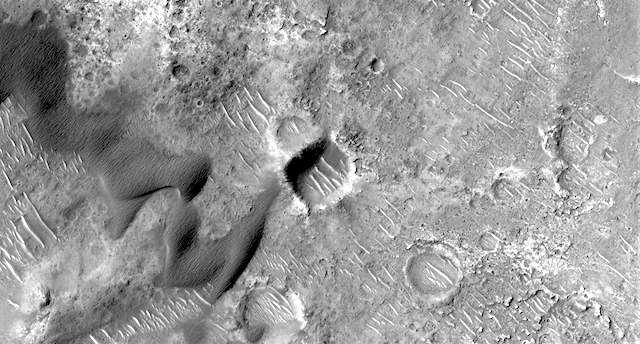 Dunes in low southern latitudes. The objective of this observation is to examine a small field of dunes.
Dunes in low southern latitudes. The objective of this observation is to examine a small field of dunes.
HiRISE Picture of the Day archive. [More at links]
 Dunes in low southern latitudes. The objective of this observation is to examine a small field of dunes.
Dunes in low southern latitudes. The objective of this observation is to examine a small field of dunes.
HiRISE Picture of the Day archive. [More at links]
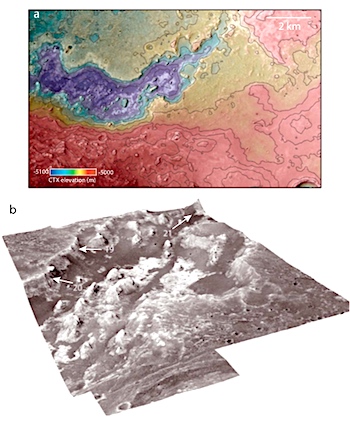 [Editor’s note: From a paper by Joseph Michalski and seven co-authors recently published in the Journal of Geophysical Research.]
[Editor’s note: From a paper by Joseph Michalski and seven co-authors recently published in the Journal of Geophysical Research.]
• McLaughlin crater contained a deep, voluminous lake >3.8 Ga with features unlike any other known Martian paleolakes
• Sedimentary units include delta deposits, turbidites, and deep‐ water sediments; and hydrothermal deposits include serpentinites
• Geochemical gradients occurred in a long‐lived lake that was in sustained
communication with groundwater and subsurface environments
Though Mars is cold, dry, and inhospitable today, it contains evidence for many dry lake beds — relics of an ancient climate that was at least episodically warmer and wetter. Considering that lakes can be an excellent environments for life on Earth, a common thread of Mars research has been to characterize the environmental conditions under which Martian lakes formed in order to better understand their implications for past habitability of the red planet.
The goal of this work is to characterize the geology of McLaughlin crater, where a lake existed on Mars over 3.8 billion years ago. McLaughlin lake was vast, deep (~ 500 m), and probably long lived. Many characteristics of McLaughlin lake are unlike those seen in any other ancient lake basins on Mars. This lake contained a range of sedimentary environments including delta deposits, shallow‐water fan deposits, and deep‐water, fine‐grained materials.
It is the only known place on Mars where fine‐grained, subaqueous “landslides” called turbidites are identified, and these are important because we know that such deposits can be sites of excellent preservation of organic matter on Earth (due to rapid burial). [More at link]
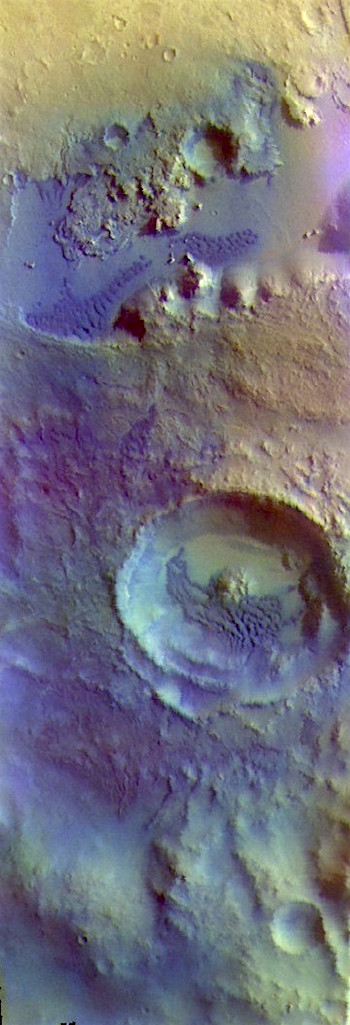 THEMIS Image of the Day, April 10, 2019. This false-color VIS image is located in an unnamed crater in Arabia Terra. Dark blue tones in false color indicate basaltic sands. These sands have created the dunes seen in this image, as well as covering large areas of ground.
THEMIS Image of the Day, April 10, 2019. This false-color VIS image is located in an unnamed crater in Arabia Terra. Dark blue tones in false color indicate basaltic sands. These sands have created the dunes seen in this image, as well as covering large areas of ground.
The THEMIS VIS camera contains 5 filters. The data from different filters can be combined in multiple ways to create a false color image. These false color images may reveal subtle variations of the surface not easily identified in a single band image.
Explore more THEMIS Images of the Day by geological subject.
 Sol 2372, April 9, 2019, update by MSL scientist Rachel Kronyak: Our drill attempt at target “Aberlady” this weekend was a success! In today’s plan we are continuing our investigation of Aberlady and the surrounding areas and preparing to deliver our drilled sample to our onboard instruments.
Sol 2372, April 9, 2019, update by MSL scientist Rachel Kronyak: Our drill attempt at target “Aberlady” this weekend was a success! In today’s plan we are continuing our investigation of Aberlady and the surrounding areas and preparing to deliver our drilled sample to our onboard instruments.
We’ll kick off the Sol 2372 plan with a short science block to analyze 2 targets with ChemCam: the inside of the drill hole (Aberlady) and a nearby bedrock target “Mayar.” We’ll also use Navcam to conduct a dust devil observation.
The next step in our drill campaign is to determine if we collected powdered rock sample and whether it is behaving as expected. Today, we’ll drop off small portions of the sample onto the workspace in front of us and on the SAM inlet cover. We’ll use Mastcam to take images before and after these drop-offs… [More at link]
 Mars may have a reputation for being a desolate world, but it is certainly not dead: its albeit thin atmosphere is still capable of whipping up a storm and, as this image reveals, send hundreds – maybe even thousands – of ‘dust devils’ scurrying across the surface.
Mars may have a reputation for being a desolate world, but it is certainly not dead: its albeit thin atmosphere is still capable of whipping up a storm and, as this image reveals, send hundreds – maybe even thousands – of ‘dust devils’ scurrying across the surface.
These swirling columns of wind scour away the top layer of surface material and transport it elsewhere. Their course is plotted by the streaks they leave behind – the newly exposed surface material, which is coloured in blue/grey in this recent image from the CaSSIS camera onboard the ExoMars Trace Gas Orbiter.
Dust devils on Mars form in the same way as those on Earth: when the ground gets hotter than the air above it, rising plumes of hot air move through cooler denser air, creating an updraft, with the cooler air sinking and setting up a vertical circulation. If a horizontal gust of wind blows through, the dust devil is triggered. Once whirling fast enough, the spinning funnels can pick up dust and push it around the surface.
As seen in this image, not much can stand in the way of a dust devil: they sweep up the sides of mounds, and down across the floors of impact craters alike… [More at link]
 Rocky layers on the floor of Fournier Crater. A nice, classic bowl-shaped crater with bright bedrock exposures on one of its walls. This is located within Fournier Crater, which is 118 kilometers in diameter.
Rocky layers on the floor of Fournier Crater. A nice, classic bowl-shaped crater with bright bedrock exposures on one of its walls. This is located within Fournier Crater, which is 118 kilometers in diameter.
HiRISE Picture of the Day archive. [More at links]
 THEMIS Image of the Day, April 9, 2019. The large crater at the bottom of today’s image is called McLaughlin Crater. It is located west of Mawrth Vallis, on the margin between Arabia Terra and Chryse Planitia.
THEMIS Image of the Day, April 9, 2019. The large crater at the bottom of today’s image is called McLaughlin Crater. It is located west of Mawrth Vallis, on the margin between Arabia Terra and Chryse Planitia.
The THEMIS VIS camera contains 5 filters. The data from different filters can be combined in multiple ways to create a false color image. These false color images may reveal subtle variations of the surface not easily identified in a single band image.
Explore more THEMIS Images of the Day by geological subject.
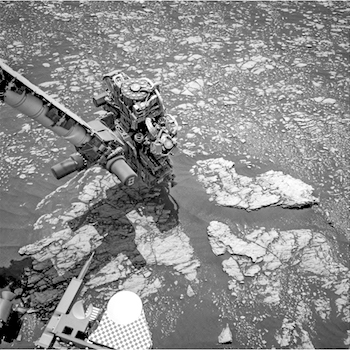 Sols 2369-71, April 5, 2019, update by MSL scientist Scott Guzewich: We are go for full drill! Today’s plan will see Curiosity execute the final preparatory steps and then drill at our “Aberlady” bedrock target (seen here underneath the rover’s arm and turret during the pre-drill APXS measurement) . This is a moment that the mission has been waiting for since Gale Crater was chosen as our landing site 8 (Earth) years ago! The clay bearing unit on the slopes of Mt. Sharp, which the rover is now parked on, is one of the primary reasons Gale Crater was selected over other competing landing sites and Curiosity’s suite of instruments is tailor made to investigate what materials comprise it. [More at link]
Sols 2369-71, April 5, 2019, update by MSL scientist Scott Guzewich: We are go for full drill! Today’s plan will see Curiosity execute the final preparatory steps and then drill at our “Aberlady” bedrock target (seen here underneath the rover’s arm and turret during the pre-drill APXS measurement) . This is a moment that the mission has been waiting for since Gale Crater was chosen as our landing site 8 (Earth) years ago! The clay bearing unit on the slopes of Mt. Sharp, which the rover is now parked on, is one of the primary reasons Gale Crater was selected over other competing landing sites and Curiosity’s suite of instruments is tailor made to investigate what materials comprise it. [More at link]
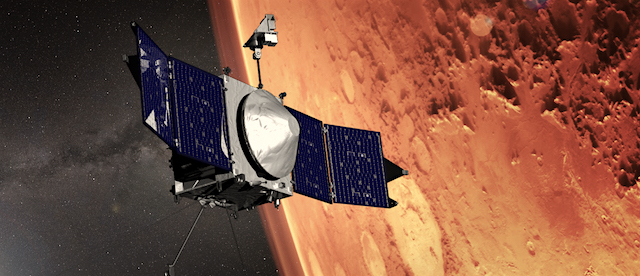 MAVEN has achieved a tighter orbit around Mars to act as a telecommunications relay. The two-month campaign began February 11 and ended April 5.
MAVEN has achieved a tighter orbit around Mars to act as a telecommunications relay. The two-month campaign began February 11 and ended April 5.
MAVEN’s navigation team slowed the spacecraft down gradually by aerobraking, a process taking advantage of the Martian upper atmosphere to place a small amount of drag on the spacecraft.
“It’s like applying the brakes on a car but instead of brake pads, we used Mars’ atmosphere,” said Stuart Demcak navigation team lead at NASA’s Jet Propulsion Laboratory in Pasadena, California.
During this time, the spacecraft periapsis altitude (lowest altitude of the orbit) lowered from 151 km (94 miles) to about 132 km (82 miles) above the Martian surface. At this altitude, the atmosphere, although extremely thin, is dense enough to provide the small amount of drag on the spacecraft necessary to slow it down. The apoapsis altitude (highest point in orbit) dropped from about 6050 to about 4570 km, an orbit change that improves MAVEN’s availability to support relay communications with NASA’s landers and rovers on the surface of Mars. The orbit period dropped from 4.4 hours to roughly 3.7 hours.
“The final post-aerobraking orbit resulted from an exhaustive series of engineering trade studies that balanced requirements for communications relay, MAVEN’s science mission, fuel expenditure, and synchronization of the orbit to provide communications support for the Mars 2020 landing,” said Russell Carpenter, MAVEN’s deputy project manager… [More at link]
Bacterial resistance to antibiotics is one of humankind’s major long-term health challenges. Now research into helping humans live on Mars could help address this looming problem.
Dennis Claessen, associate professor at the Institute of Biology in Leiden University, the Netherlands works in synthetic biology, in which bacteria are engineered to solve problems that cannot be tackled – or are not tackled well – by ‘wild’ bacteria. A team of his students entered the iGEM International Genetically Engineered Machine competition with a solution to the problem of growing non-toxic plants on Mars, but needed ‘Martian’ gravity to test their ideas.
“The soil on Mars has perchlorate chemical compounds in it, which can be toxic for humans,” explains Prof. Claessen. High doses of perchlorate can inhibit the thyroid gland’s uptake of iodine and interfere with foetal development.
“Our students started ‘building’ a bacterium that would degrade the perchlorate to chlorine and oxygen, but they needed to know whether that bacterium would behave the same way in the partial gravity of Mars as it would on Earth.” The challenge was to find a way to reproduce Mars gravity on Earth, and the students solved it using a random positioning machine (RPM). (…)
As its name suggests, the RPM continually changes its orientation at random, so that items placed within it have no opportunity to adjust to a steady gravity direction. The original design could successfully simulate zero gravity while the newer RPM 2.0 can additionally simulate partial gravity, the stages between normal Earth gravity and the weightless environment… [More at link]